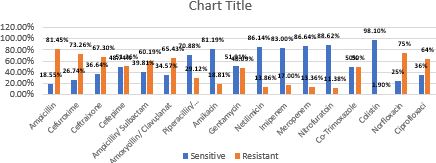A study on evaluation of Escherichia coli isolates in urinary tract infection and its antibiogram in view of Emerging drug resistance at a tertiary care hospital
Abstract
Introduction: Urinary tract infection is a common problem in routine clinical practices despite age and sex, and it is also the most common nosocomial infection. The most common uropathogen is Escherichia coli worldwide.
Material and methods: A retrospective study was conducted from January 2020 to December 2020 in a tertiary-care hospital in South India. All positive urinary cultures with significant bacteriuria received from Inpatient and outpatient wards of various departments were included in the study. The prevalence percentage of different bacteria was studied. Multidrug-resistant (MDR), extensively drug-resistant (XDR), and pan drug-resistant (PDR) Escherichia coli in different baseline and demographic characteristics were evaluated.
Results: A total of 2144 urine samples were processed for culture and sensitivity, out of which 531 samples were found to be culture-positive with significant bacteuria. Among 531 samples, 202 (38%) culture positives were due to Escherichia coli infection. Women (62%) were more susceptible to infection. The predominant age group affected among women was 21-30 yrs and men 51-60 years. Of these, 28% exhibited an MDR pattern, 18% XDR and 1.9% PDR.
Conclusion: Treatment of Urinary tract infection due to E. coli may be difficult due to high resistance to commonly used antibiotics. So continuous surveillance of drug-resistant organisms and evaluation of drug resistance patterns are needed to prevent treatment failure and to reduce the economic burden due to these resistant isolates.
Downloads
References
Patterson JE, Andriole VT. Bacterial urinary tract infections in diabetes. Infect Dis Clin North Am. 1997 Sep;11(3):735-50. doi: 10.1016/s0891-5520(05)70383-4.
Odoki M, Almustapha Aliero A, Tibyangye J, Nyabayo Maniga J, Wampande E, Drago Kato C, et al. Prevalence of Bacterial Urinary Tract Infections and Associated Factors among Patients Attending Hospitals in Bushenyi District, Uganda. Int J Microbiol. 2019 Feb 17;2019:4246780. doi: 10.1155/2019/4246780.
Elsayah, Khadija, Ahmed Atia, and Nafisah Bkhait. Antimicrobial resistance pattern of bacteria isolated from patients with urinary tract infection in Tripoli city, Libya. 4Asian Journal of Pharmaceutical and Health Sciences 7.4 (2017)./863
Gupta K, Hooton TM, Stamm WE. Increasing antimicrobial resistance and the management of uncomplicated community-acquired urinary tract infections. Ann Intern Med. 2001 Jul 3;135(1):41-50. doi: 10.7326/0003-4819-135-1-200107030-00012.
Alós JI, Serrano MG, Gómez-Garcés JL, Perianes J. Antibiotic resistance of Escherichia coli from community-acquired urinary tract infections in relation to demographic and clinical data. Clin Microbiol Infect. 2005 Mar;11(3):199-203. doi: 10.1111/j.1469-0691.2004.01057.x.
Sire JM, Nabeth P, Perrier-Gros-Claude JD, Bahsoun I, Siby T, Macondo EA, et al. Antimicrobial resistance in outpatient Escherichia coli urinary isolates in Dakar, Senegal. J Infect Dev Ctries. 2007 Dec 1;1(3):263-8.
Magiorakos AP, Srinivasan A, Carey RB, Carmeli Y, Falagas ME, Giske CG, et al. Multidrug-resistant, extensively drug-resistant and pandrug-resistant bacteria: an international expert proposal for interim standard definitions for acquired resistance. Clin Microbiol Infect. 2012 Mar;18(3):268-81. doi: 10.1111/j.1469-0691.2011.03570.x.
Malik, Shikha, Jogender Singh Rana, and Kiran Nehra. Prevalence and antibiotic susceptibility pattern of uropathogenic Escherichia Coli strains in sonipat region of Haryana in India." Biomedical and Biotechnology Research Journal (BBRJ) 5.1 (2021): 80.
Munoz-Dávila MJ, Roig M, Yagüe G, Blázquez A, Salvador C, Segovia M. Comparative evaluation of Vitek 2 identification and susceptibility testing of urinary tract pathogens directly and isolated from chromogenic media. Eur J Clin Microbiol Infect Dis. 2013 Jun;32(6):773-80. doi: 10.1007/s10096-012-1806-4.
Clinical and Laboratory Standards Institute. Performance standards for antimicrobial susceptibility testing; 29th informational supplement. CLSI Document 2019. Wayne, PA: Clinical and Laboratory Standards Institute; p. M100-S29.
Benkő R, Gajdács M, Matuz M, Bodó G, Lázár A, Hajdú E, et al. Prevalence and Antibiotic Resistance of ESKAPE Pathogens Isolated in the Emergency Department of a Tertiary Care Teaching Hospital in Hungary: A 5-Year Retrospective Survey. Antibiotics (Basel). 2020 Sep 19;9(9):624. doi: 10.3390/antibiotics9090624.
Cui X, Zhang H, Du H. Carbapenemases in Enterobacteriaceae: Detection and Antimicrobial Therapy. Front Microbiol. 2019 Aug 20;10:1823. doi: 10.3389/fmicb.2019.01823.
Thattil, Santhosh John, and Sumitha Santhosh. Prevalence of UTI in different age groups in a tertiary care hospital and their antibiogram. International journal of contemporary medical research 5.1 (2018): 3-6.
Mouanga Ndzime Y, Onanga R, Kassa Kassa RF, Bignoumba M, Mbehang Nguema PP, Gafou A, et al. Epidemiology of Community Origin Escherichia coli and Klebsiella pneumoniae Uropathogenic Strains Resistant to Antibiotics in Franceville, Gabon. Infect Drug Resist. 2021 Feb 16;14:585-594. doi: 10.2147/IDR.S296054.
Gupta S, Kapur S, Padmavathi D. Comparative prevalence of antimicrobial resistance in community-acquired urinary tract infection cases from representative States of northern and southern India. J Clin Diagn Res. 2014 Sep;8(9):DC09-12. doi: 10.7860/JCDR/2014/9349.4889.
Malik, Shikha, Jogender Singh Rana, and Kiran Nehra. Prevalence and antibiotic susceptibility pattern of uropathogenic Escherichia Coli strains in sonipat region of Haryana in India. Biomedical and Biotechnology Research Journal (BBRJ) 5.1 (2021): 80.
Ramírez-Castillo FY, Moreno-Flores AC, Avelar-González FJ, Márquez-Díaz F, Harel J, Guerrero-Barrera AL. An evaluation of multidrug-resistant Escherichia coli isolates in urinary tract infections from Aguascalientes, Mexico: cross-sectional study. Ann Clin Microbiol Antimicrob. 2018 Jul 24;17(1):34. doi: 10.1186/s12941-018-0286-5.
Niranjan V, Malini A. Antimicrobial resistance pattern in Escherichia coli causing urinary tract infection among inpatients. Indian J Med Res. 2014 Jun;139(6):945-8.
Basak S, Singh P, Rajurkar M. Multidrug Resistant and Extensively Drug Resistant Bacteria: A Study. J Pathog. 2016;2016:4065603. doi: 10.1155/2016/4065603.

Copyright (c) 2022 Author (s). Published by Siddharth Health Research and Social Welfare Society

This work is licensed under a Creative Commons Attribution 4.0 International License.


 OAI - Open Archives Initiative
OAI - Open Archives Initiative


